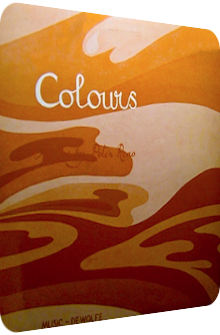
Peter Reno
Colours
1969
Colours is a rainbow of ten lanes (tracks) by British composer Cliff Twemlow, better known under his moniker Peter Reno (1937–1993), played by the London Studio Orchestra, conducted by Keith Papworth and released in 1969 on the biggest library music label De Wolfe Music whose back catalog comprises of approximately 80,000 items… and ever-counting. Having worked as an actor and even a night bouncer for many years, Reno’s vivacious records do not even cast a shadow of a cloud and are loaded with wonderful string washes, silky brass infusions and all-new melodies. As expected, Reno dedicates each respective track to a color, and while this has been done multiple times before and ever since, Colours does camouflage its status as library music flawlessly. Had this been released on Capitol or Columbia in an alternative reality, it would have been cited by Space-Age fans time and again. The album is not Exotica-related per se, but succeeds with its picturesque flutes, turquoise vibraphones, and luminous horn helixes.
Nelson Riddle’s Changing Colors (1971) comes to mind both due to its title and similar arrangements, but Reno’s album is also compatible with many other like-minded artists, but more about them later. Momentarily, it is important to fight a certain feeling and the raised brow or two: Peter Reno has written approximately 2000 unique compositions. Ten of them are gathered on this album and are specifically created for advertisers, film makers and radio play writers for use in their productions. So the pressing question is whether the album does even have an aesthetic value since it is clearly produced in a hasty manner, right? Obviously, I cannot give the ultimate answer, but can state one tendency very firmly: the more the album progresses, the more enchanting the melodies and overtones become. Here is a closer look at Peter Reno’s Colours.
Yellow, how I like thee! The preferred color of children which they use to paint the sun is transformed into music by Reno via pointillistic fairy tale flutes, wafting strings and horns en masse. The mood is swinging, joyful and bright, but admittedly chintzy and loaded with Easy Listening stereotypes, so I for one do indeed pinpoint the opener as a little disappointment. The following Red is way catchier. No love theme is presented; this is more of another swinging midtempo piece where the flute flumes are much better encapsulated by darker strings and horns residing in lower frequencies. Therefore, even the main melody of the saxophone knows to enchant. Add piano sprinkles to the scenery and consider the four-note leitmotif, and Red turns out to be a Space-Age artifact par excellence, very euphonious and soothing.
Whereas the fittingly semi-mourning Blue introduces cavalcades of frosty vibraphones and is drowned in shawm-like horns in tandem with strangely diffuse strings, Silver is one of those archetypically British Singing In The Rain-evoking ditties which enmeshes glockenspiel dots with the attitude of shrugged shoulders; the muted horns are interchanged with gorgeously twirling strings, the mood is uplifting, one can really imagine a dancing guy in the streets. Hollywood really does penetrate the collective mind. Side A closes with Purple and is presented in an oddly gypsy-like Waltz structure. The strings are more serious and grave, the trumpets form blithesome counterparts, as do the polyphonic flutes. Otherwise, this tune is almost torn apart by its melancholia.
Side B opens with the delightful Orange, a potentially syrupy piece of effervescence which is luckily rescued by its wondrously half-cacophonous wonky piano notes. These traverse the whole composition, illumining the fluffy flutes and gleaming brass instruments with their omnipresence. A catchy piece akin to Silver, and with a great show tune ending. Brown is equally successful and a piano arrangement at its core, with the tone sequences of the adjacent strings being particularly warped and seemingly gaseous, thereby inheriting that Space-Age feeling. The downwards spiraling flute-accentuated notes and the Lo-Fi approach altogether make this a superb and unexpectedly varied arrangement with an exclusively good mood. A library music corker!
The prelude of the follow-up White at first takes over the mood range from Brown but then turns into a pre-Funk wonderland with electric bass rivers, sun-soaked acoustic guitar aortas, spiraling flute cavalcades and vibraphone-glockenspiel couples which scintillate and sparkle their way through the chaparral of strings and horns. Three splendid belters in a row, side B is superior! Whereas Gold manages to rev up the glitzscape of White and unchains coruscating glockenspiels in close proximity to the vibraphone-infested cocktail of strings and benignantly streamlined horns, the finale comes in the shape of Green, a prototype for a dancing scene on verdured meadows. It does not evoke the clichéd scenery of two lovers approaching each other with open arms, but rather creates the insouciance of a wonderful summer day. Again, there are euphony and euphoria all over this piece, making side B a place of literal technicolor enchantment.
Whenever I review releases of the De Wolfe Music label, it comes down to this: I usually conclude the review with the sentence that the respective work does not feel like a library work. Unsurprisingly, it is exactly the same with Colours. While it is not nearly as exotic as Peter Reno’s other works such as Blue Pacific (1969) or Native Rhythms (1972), it comprises of skillful arrangements that are far greater and more prolific than the label-related surroundings might suggest. The concept of transforming colors into music is an ancient one, and you will find a related work in every genre one can think of, but strip off the color scheme and concentrate solely on the music, and Reno’s work shimmers iridescently. This is especially applicable in terms of side B. Tunes like the designedly tipsy Orange or the luminescent Gold are earworms in the true sense of the term, but even side A enthralls with pieces such as Silver or the astutely nocturnal-chilling Blue.
This album lacks the truly exotic vibe, i.e. Latin percussion or mountainous panoramas, and yet it can be counted to the inner peripheries of the Space-Age movement. If you like Dominic Frontiere’s Love Eyes (1960) or Bert Kaempfert’s Forever My Love (1975) – both of which only coincidentally carry the marker of love in their titles – chances are that Colours is up your alley, as the adage goes, for its carefree, frolicking melodies and similarly brass-fueled string orchestrations share many attributes with said works. Unfortunately, Colours is not yet available as a digital reissue, but my hope is that De Wolfe Music will one day flood its own music store with their gemstones that would even put games like Boulder Dash or Bejeweled to shambles. This is library music which outshines the belittling picayune impression.
Exotica Review 320: Peter Reno – Colours (1969). Originally published on Mar. 1, 2014 at AmbientExotica.com.
